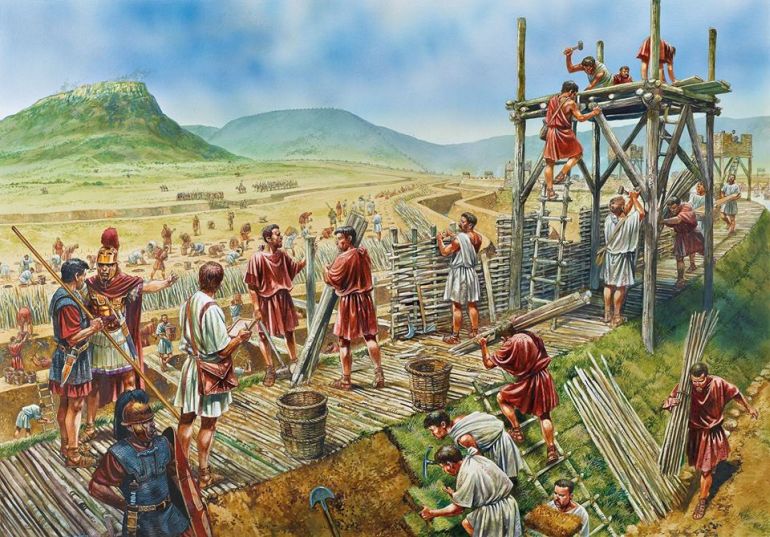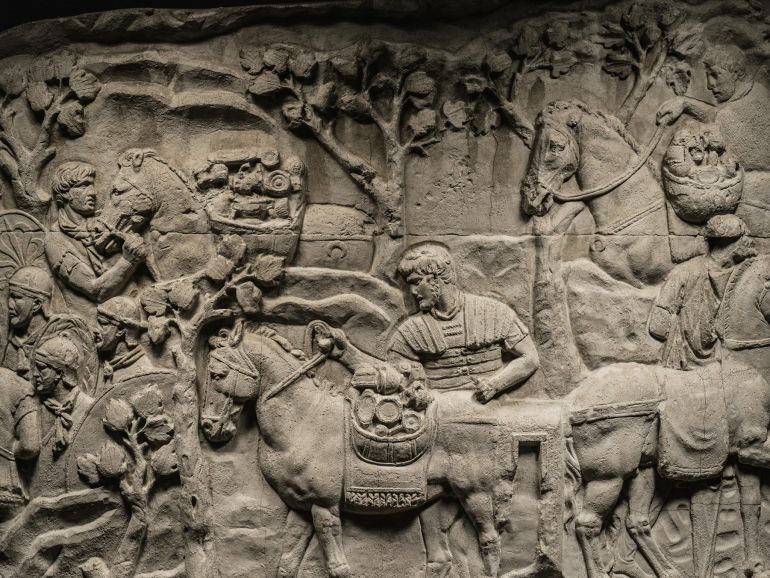Much has been said about the armament or tactics of the famous Roman legions. However, what did the life of an ordinary legionary look like? Below are 10 interesting facts about how the world of legionaries looked like1.
I. Legions preferred people from the lower strata
All Roman men aged 17-46 could serve in Roman legions – the ideal age was the twenties. Each recruit had to prove his origin (origo). Mostly, however, the army consisted of “rural” boys who were looking for a way of life and a secure income. They were usually more valued because they were characterized by greater strength and resistance to effort. In addition, they were more susceptible to obeying orders and punishments due to their simple nature.
This is how Vegetius describes the village recruit:
We shall next examine whether the city or the country produces the best and most capable soldiers. No one, I imagine, can doubt that the peasants are the most fit to carry arms for they from their infancy have been exposed to all kinds of weather and have been brought up to the hardest labor. They are able to endure the greatest heat of the sun, are unacquainted with the use of baths, and are strangers to the other luxuries of life. They are simple, content with little, inured to all kinds of fatigue, and prepared in some measure for a military life by their continual employment in their country-work, in handling the spade, digging trenches and carrying burdens.
– Vegetius, De re militari
It was sometimes suspected that all revolts in the army were born among soldiers of urban origin because they could not cope with discipline.
Along with the decision to admit the recruit to the legion followed the so-called period probatio. It was a moment when the military assessed the man’s character and health. At that time, it was not allowed to accept, for example, thieves or criminals or persons with disabilities who could threaten the security of the whole unit.
As Vegetius says:
The young soldier, therefore, ought to have a lively eye, should carry his head erect, his chest should be broad, his shoulders muscular and brawny, his fingers long, his arms strong, his waist small, his shape easy, his legs and feet rather nervous than fleshy. When all these marks are found in a recruit, a little height may be dispensed with, since it is of much more importance that a soldier should be strong than tall.
– Vegetius, De re militari
II. Necessary free birth
It should be noted that the Roman legionary did not have to have Roman citizenship. Such liberalization was born during the civil wars that struck Rome at the end of the Republic in the middle of the 1st century BCE. For example, Julius Caesar created the legion V Alaudae entirely from recruits of Gallic descent, who later gave Roman citizenship. Even at the end of the first century BCE, Mark Antony, having no access to Italy and its resources, began to fill the gaps in his 23 legions with local people – Egyptians, and Syrians.
Citizenship was not a requirement, but only the status he was entitled to at the time of recruitment. An indispensable factor was being a free man. Slaves were not allowed to join an army enlistment. However, they held servants in the army.
During the civil wars, shortcomings in the army were often supplemented by forced recruitment. Roman historian Tacitus mentions that Emperor Tiberius even went personally on a trip to the province to recruit – in the place of veterans – an army of new recruits.
III. Extremely strict workouts
After successful recruitment, the “fresh” legionary had to undergo a 4-month training. During this time he had to march 29 km for five hours, in a normal step; and then 35 km in five hours, at a fast pace – all the time carrying his belongings on his back weighing about 20, 5 kg. This weight was usually increased during training in order to temper the soldiers even better. Those who could not keep up were “treated” with a stick by centurions and helpers.
Attention was also paid to the speed and efficiency of soldiers:
But the young recruits in particular must be exercised in running, in order to charge the enemy with great vigor; occupy, on occasion, an advantageous post with greater expedition, and prevent the enemy in their designs upon the same; that they may, when sent to reconnoiter, advance with speed, return with greater celerity and more easily come up with the enemy in a pursuit.
– Vegetius, De Re Militari
After practising strength and character, there was a time to learn formation (empty square, wedge or testudo) and signalling. Finally, newly recruited soldiers were taught to use weapons. Exercises, however, were carried out using wooden and wicker swords or shields that were heavier than a real weapon. In this way, the legionary was acquainted with the fatigue and exhaustion that could appear on the battlefield.
IV. Length of service and pay
Emperor Octavian August finally determined the length of the legionary’s service in 16 BCE as 16 years. After this period, it was expected that the hardened soldier would join the vexillum veteranorum or veteran unit for four consecutive years. In 6 CE the service was extended to 20 years and the so-called praemia militare, which is a form of retirement pension paid to veterans in the amount of 12,000 sesterces (3,000 denarii). Over time, veterans received land instead of money.
In the middle of the first century CE, the service was finally 25 years old. However, all military reports were less and less followed, and some legionaries could boast of 30 or even 40 years of military service.
In addition to payment (after serving more years), praemia militare legionaries received a pay of 900 sestertii per year (paid in three tranches). Wages remained constant until around 80 CE, despite rising inflation. Naturally, however, the pay varied depending on the rank – specialists, e.g., received 1.5, 2 or 2 times more pay.
V. Temptation of loot and plunder
What often encouraged young people to join the army was the prospect of gaining great spoils during the war campaigns. Leaders wanting to gain the support of their soldiers allowed for plunder and robbery in the captured cities.
There were rules regarding plundering in the Roman army. When the city was stormed, all the spoils were divided among legionaries. If the city surrendered itself, the senior officers decided about the distribution of loot.
The fact that the allocation of loot was an important element for the integrity of the Roman army is testified by the account of Livius, who mentioned the rebellion of the army stationed under Sukron (in Spain) in 206 BCE According to an ancient historian, the decline in soldier’s discipline took place there, among others, “because they were used to living from quite abundant spoils gained on the enemy”2.
In the case of conquering a hostile city, the Romans quite often carried out not only their plunder but also murders of the population inhabiting them. The acts of crime on the civilian population of the captured city were carried out in two ways: by order of the main commander or on his own responsibility.
In Roman war doctrine, however, it was not accepted that Roman people, especially women and their virtue, would suffer. During the civil war in Spain, Roman commander Sertorius (1st century BCE) ordered the loss of the entire 500 people cohort. He did it because one of the soldiers of this unit tried to rape a Roman citizen.
VI. Brotherhood
In addition to discipline and training, the brotherhood had a great impact on the quality of the Roman army. Roman Centuria with 80 people, was divided into 10 contubernium, of 8 soldiers. They shared a tent, spent their free days, marched, practised and fought. They were brothers in arms and often undertook to contact the family of a fallen companion.
In ancient Rome, the comrade-in-arms was commonly referred to as commilito or contubernalis.
The Romans also used terms like brotherhood (fraternitas) and friendship (amicitia). Really close relationships could lead to friends designating each other in the will as principal heirs (heres eius) of the estate (peculium castrense) if the deceased had no close family. Sometimes in a will, comrades-in-arms were mentioned by name for the execution of the bequests, in return for compensation from the savings that the soldier had accumulated over the years of service or from items that belonged to him (slaves, jewellery, etc.).
An interesting story is presented to us by Josephus Flavius, when a certain Artorius, trying to save himself from the besieged temple in Jerusalem, makes a promise to his companion:
There was one Artorius that delivered himself from the fire by his subtlety. Being reduced to an extremity, he called out to Lucius, one of his fel|low soldiers, solemnly declaring, “that if he would catch him in his arms, and break his fall, he would make him his heir.” Artorious accordingly took his leap; and the other disposing himself to receive him, the weight of the one dashed the other with such violence on the stone pavement, that he im|mediately expired.
– Josephus Flavius, Jewish War, III.3
VII. Cowardice was severely punished
The word decimation nowadays usually means the destruction of the environment, population or ecosystem. In Roman times, the term was used to describe the punishment that Roman generals used on their disobedient troops to discipline them properly. Decimatio consisted of the drawing of every tenth soldier from the cohort (480 people), who was then stoned or beaten by his companions – the so-called fustuarium.
The remaining legionaries, instead of allocating wheat, were given barley and punished with additional quartering outside the fortified camp until they wiped their offences in battle. Due to the serious weakening of the personality, decimation was gradually abandoned.
This severe punishment was applied to a cowardly or rebellious group of soldiers. They also punished a squad mate, for desertion, pretending to be sick or failing to appear on the battlefield.
More about punishments in Roman legions.
VIII. Medicine
If the legionary was seriously injured and could not continue serving, he would receive missio causaria or honesta missio – in this way a well-deserved and heroic soldier received, as a reward from his homeland, exemption from paying taxes and other persistent issues for other Romans.
However, given the fact that in ancient times even with qualified camp medic (medici), it was hard to save a seriously injured legionary, there was usually little chance of implementing missio causaria.
As shown in the relief from Trajan’s Column, medical personnel were also present during the battle. The medical staff was behind the banners, not far from the headquarters. Certainly, before the wounded were brought to the “battle hospital”, they first received first aid from capsaria – medical helpers. Some soldiers volunteered and brought the wounded from the battlefield on their horses. In return, they could count on additional remuneration; from everyone saved. Capsarii bandaged the wounded with the so-called fascia (bandages), which was worn in capsae (bags).
From the field hospital, the wounded were transported on horse-drawn carts to local stationary camp hospitals. There, too, surgeons (medici vulnerarii) and medici took care of their health. The wounded were given beds (the largest hospitals had up to 500 beds), and in the absence of places, the commander placed the injured in civilian buildings
IX. Professionals
The Roman army was an efficient war machine, which was also based on exceptional specialists – immunes. It was a group of highly trained specialists assigned to the legion. Among them were, other doctors, engineers, architects, artillerymen, musicians, drill instructors, fencing instructors, carpenters, and hunters. In practice, they earned better than ordinary legionaries. Of course, they also took part in the fighting, but they were given additional roles because of their skills.
To become a specialist (without any knowledge) you had to serve a few years as a typical walker (milites or munifex). After this time, it was possible to apply for the transition of additional training to a specialist. The soldier during the “qualification” was called discens.
X. Scutum was also attacked
The traditional shield of the Roman legionary was scutum. A typical shield in the 1st century BCE was oval in shape and weighed about 10 kg. However, during the Augustów era, scutum took the form of a rounded rectangle. This change drastically reduced the weight of the weapon to 7.5 kg and retained its defensive qualities – a 102 cm x 63 cm shield still covered the legionary’s torso.
As it turned out, the shield also took on an offensive character. Inside it was reinforced with iron or bronze umb. Polybius gives thanks to the fitting of the centre, the shield in close combat served as an offensive weapon allowing “to push” on the opponent. The top and bottom of the shield were forged with iron, which was also used in offensive combat.
The shield was large enough to cover the entire legionary’s torso and slightly convex, which in turn meant that the opponent’s blows slipped on an uneven surface.
















